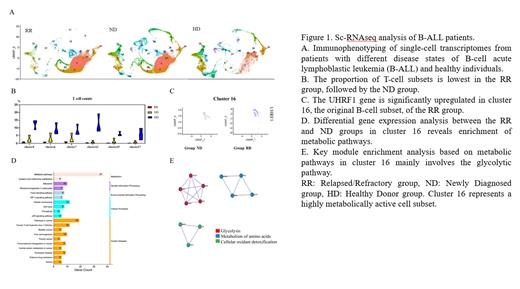Background
Acute lymphoblastic leukemia (ALL) is a hematologic malignant disease with high heterogeneity, including B-ALL and T-ALL. The 5-year overall survival rate of children ALL has been significantly improved, which is over 90%. However, the prognosis of adult patients is not satisfactory, and the 5-year OS is only 30%-50%. Among them, the prognosis of patients with relapsed/refractory B-ALL is very poor. Exploring the molecular mechanism of disease progression is of great significance to improve the outcome.
Methods
Application of 10× Genomics chromium sequencer reveals the single-cell transcriptome profiling of peripheral blood or bone marrow MNC cells, which were from 6 patients with B-ALL(3 new diagnosed patients and 3 relapsed patients) and 3 healthy donors. The expression of key genes in 84 clinical blood or bone marrow samples was detected, and the prognosis was analyzed in TARGET database by bioinformatics technology. The molecular mechanism was investigated by RNAseq, 850k methylation microarray, qRT-PCR, Western blot, BSP, CHIP-qPCR and flow cytometry. Additionally, we identified a UHRF1 inhibitor using virtual compounds screening, and demonstrated its therapeutic efficacy both in vitro and vivo.
Results
Using Seurat method to cluster and dimension reduction of scRNA-seq data, 29 subclusters were obtained from 9 clinical samples. It mainly includes eight progenitor B cells, one B cell, six T cells, two NK cells, three monocytes, two neutrophils and three primordial erythrocytes. Nine samples were divided into three groups: Newly Diagnosis group (ND), Relapsed/Refractory group (RR) and Healthy Donors group (HD). The proportion of three subpopulations (cluster 2,5,16) in progenitor B cell group showed a decreasing trend of RR group > ND group > HD group. The marker genes of these three subgroups were enriched by GO and KEGG using ClusterProfiler R package. Cluster 2 was enriched into cancer signal pathway, cluster 5 was enriched into DNA replication process, and the marker genes of cluster 16 was mainly involved in metabolic pathway. The differential expression of these three subgroups between RR group and ND group was analyzed by FindMarkers function. The results showed that cluster 16 was the main differential cluster. The intergroup differential genes of cluster 16 mainly involve metabolic pathway, cancer pathway, cell cycle and p53 signaling pathway (Figure 1).
The three groups were compared in pairs. After the intersection of differential genes in cluster 16 and all progenitor B cell groups, four common differential genes (HSPB1, UHRF1, H1F0 and IGFBP2) were screened. The results showed that the expression of UHRF1 gene was up-regulated in acute lymphoblastic leukemia patients, especially in patients with relapsed/refractory. Moreover, UHRF1 overexpression is an independent prognostic risk factor for B-ALL patients in our clinical data, and it is also a molecular marker of poor prognosis in the TARGET dataset.
In vitro experiments, knockout of gene UHRF1 promoted the cycle arrest and apoptosis of B-ALL tumor cell line (Reh and nalm6), inhibited the proliferation of cells, and improved the drug sensitivity of vindesine. RNAseq and methylation microarray showed that the gene SFRP5 was demethylated and the expression of mRNA was overexpressed in UHRF1 knockout cell lines. This was verified by subsequent qRT-PCR, Western Blot and Bisulfite sequencing. Further studies showed that UHRF1 was involved in glycolysis by regulating the SFRP5-p38 MAPK-HK2 signal axis. Subsequently, through overexpressing SFRP5, we confirmed that upregulating SFRP5 can inhibit the P38 MAPK-HK2 signaling pathway, thereby suppressing glycolytic levels. Moreover, virtual compound screening identified UM164 as an inhibitor of UHRF1, which significantly inhibits P38 protein phosphorylation, downregulates HK2 expression, and reduces the production of glycolysis-related metabolites. Furthermore, UM164 demonstrated the ability to inhibit the proliferation of B-ALL cells both in vitro and in vivo, leading to prolonged survival in a B-ALL mouse model.
In conclusion, we have unraveled the molecular mechanisms of epigenetic and metabolic rearrangements in relapsed/refractory B-ALL, and have provided potential targeted therapeutic strategies to improve its unfavorable prognosis.
Disclosures
No relevant conflicts of interest to declare.


